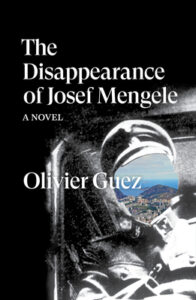By Olivier Guez; translated by Georgia de Chamberet
 One Dec. 25th, over dumplings and General Tsao chicken, friends and I discussed a movie we’d just seen: “12 Years a Slave.”
One Dec. 25th, over dumplings and General Tsao chicken, friends and I discussed a movie we’d just seen: “12 Years a Slave.”
One person said the casting was magnificent, another praised the direction. One person said it was dark and depressing and she wished she hadn’t seen it.
Had I enjoyed it? I asked myself. No, actually. It was a brutal movie about a free black man kidnapped and sold into slavery, which he was unable to escape from for 12 years.
Enjoyable or not, it was an important movie with a type of story rarely told and powerfully done.
Much the same applies to French journalist Oliver Guez’s novel, THE DISAPPEARANCE OF JOSEF MENGELE. You will by turns be horrified, angered, nauseated and ready to put the book down.
This is a well-researched mystery story outlining how Dr. Josef Mengele, “The Angel of Death” at Auschwitz, eluded capture from the end of World War II in 1945 until his death by drowning off the coast of Brazil in 1979.
But it’s also the story of a soulless sadist, poisoned by his fear of capture, dependent on his family’s money for survival, helped by assorted Nazis and at the mercy of people who saw him only as an income source.
Guez does discuss Mengele’s crimes at Auschwitz, including leading selections when trains of Jewish prisoners arrived when Mengele indicated who would go to the work camps and who would go to the gas chambers. He describes some of Mengele’s senseless, sadistic medical experiments as well.
He clearly shows why Mengele should have been known to Allied forces, immigration officials and embassy personnel. Disguised as an Army officer, Mengele was taken as a prisoner of war by the Americans in June 1945. Although he registered under his own name, he didn’t have the usual SS blood type tattoo. He was released at the end of July 1945.
He got false papers, spent several months on the run, worked on a farm in Bavaria. Fearing capture and trial, he escaped from Germany in April 1949. Helped by a network of former SS members, he sailed to Argentina in July 1949.
Argentine President Juan Perón welcomed Nazis. A former general himself, he had long admired militaristic dictators such as Hitler and Mussolini. He saw an open door to fleeing Nazis as a way to acquire a brain trust that would raise Argentina’s world status.
Buenos Aires in the late 1940s, according to Guez, was “the capital of the rejects of the fallen Black Order. A melting pot of Nazis, Ustashe Croatian counter-revolutionaries, Serbian ultra-nationalists, Italian Fascists, Hungarian Arrow Cross Party members, Romania’s Iron Guard legionnaires, Vichy French, Belgian Rexists, Spanish Falangists, fundamentalist Catholics; killers, torturers and adventurers: a ghostly Fourth Reich.”
For awhile, Mengele lived a comfortable life in Buenos: dining out; building a business using his family’s money; living in a California-style villa near the shore of the Rio de la Plata; spending hot summer weekends at former Nazi pilot Dieter Menge’s estancia. Menge felt so comfortable with his Nazi identity that he put a bust of Hitler in his garden and a granite swastika on the bottom of his swimming pool.
Just seven years after arriving in Argentina, Mengele is able to get a residence card in his own name. The West German embassy even gives him a passport in his own name. He is able to fly back to Europe to meet his son for the first time and his widowed sister-in-law, whom he eventually marries.
This golden life falls apart when Mengele and several other doctors are brought in by the police after a young woman dies after a botched abortion. (Illegal abortions were one of the ways Mengele earned extra income.)
Fearful that his identity would be uncovered he fled to Paraguay. There he worked as a traveling salesman promoting his family’s agricultural machinery.
When a Mossad team captured Adolph Eichmann, one of the major organizers of the “Final Solution” in May 1960, Mengele decides to disappear and reinvent himself. Using family money, he invests in a coffee and cattle plantation in Brazil with Hungarian expatriates Géza and Gitta Stammer. The Stammers are introduced to Mengele under a false name. They soon learn who he is but are more interested in Mengele’s money than his history.
Mengele lives in a state of corrosive paranoia. He is surrounded by a pack of stray dogs that he uses for protection and as a warning system in case of intruders. He builds a tower and spends hours with binoculars looking for anyone approaching the ranch. He bullies the Stammers’ employees and gives them unwelcome advice about how to raise their children.
Eventually, Mengele and the Stammers part ways. The Stammers buy a bungalow in a neighborhood of São Paulo that they rent to Mengele. He lives in poverty, paranoia and increasingly poor health. In 1979, he has a stroke while swimming on the Atlantic coast and drowns. He is buried under the name of Wolfgang Gerhard, whose identity he had been using since 1971.
In May 1985, the West German prosecutor’s office raided the office of Hans Sedlmeier, a lifelong friend of Mengele’s and sales manager of the family firm. There, they found a coded address book and copies of letters sent to and received from Mengele, including a letter informing Sedlmeier of Mengele’s death.
German authorities alerted the police in São Paulo. They in turn interrogated Wolfram and Liselotte Bossert, whom Mengele was visiting at the time of his death. They revealed the location of Mengel’s grave. Forensic examination in June 1985 showed a high degree of probability that the body was that of Josef Mengele. In 1992, DNA testing confirmed it beyond a doubt.
Mengele remained an unrepentant Nazi to the end. His son came to visit toward the end of Mengele’s life, spent less than a day with him and returned to Germany and changed his name to his wife’s maiden name.
This is a deeply challenging book to read. Mengele is a repulsive protagonist. A reason to be outraged can be found on every other page: how he escaped trial, how assorted civil servants never connected the dots and allowed him identity documents and freedom to travel back and forth to Germany.
That said, this is an important and exceptionally well-done book. It’s described as a novel because it includes conversations and thoughts that no one could have known, but it is based on deeply researched material. Some of that material only became available in the late 1980s when Argentine President Carlos Saul Menem ordered the release of files relating to Argentina’s role in offering a haven to Nazi war criminals.
THE DISAPPEARANCE OF JOSEF MENGELE was originally published in Paris in 2017 and translated by Georgia de Chamberet. It won the Prix Renaudot in 2017.
The Author: Olivier Guez (1974 – )
 Olivier Guez is a French journalist, essayist and writer. He worked as a freelance journalist for The New York Times, Le Monde, the Frankfurter Allgemeine Zeitung, Le Figaro Magazine, L’Express, Le Point and other publications.
Olivier Guez is a French journalist, essayist and writer. He worked as a freelance journalist for The New York Times, Le Monde, the Frankfurter Allgemeine Zeitung, Le Figaro Magazine, L’Express, Le Point and other publications.
He won the Priz Renaudot for his 2017 novel, THE DISAPPEARANCE OF JOSEF MENGELE. It was his seventh book.
Raised in Strasbourg, he studied at Sciences Po Strasbourg, the London School of Economics and the College of Europe.


